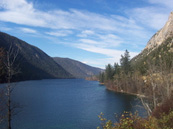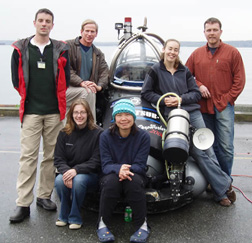Wednesday, 18 June 2008
 Pavilion Lake, BC is about 420 kilometers northeast of Vancouver — in Marble Canyon not far west of Kamloops, and "within the traditional territory of the Ts’kw’aylaxw people, and the Pavilion First Nations Indian Band." Especially this time of year, the lake is "clear ... and warm ... surrounded by large old growth fir trees, and ... so sparkling clean, you can see the bottom and watch the fish." It also hosts "unique ... freshwater microbialites — reef-like structures that resemble fossils of what's believed to be the first life forms on Earth." Moreover, "conditions on ancient Mars ... likely resembled those on Earth at the time the original microbialites thrived." So from June 23 to July 3 this year "researchers from two Canadian universities, NASA and the Canadian Space Agency" will undertake a Pavilion Lake exploration that "they hope will also help in eventually sending people to the moon and then Mars." To help access the lake’s scientific treasures, the project will be deploying innovative "Deepworker submersibles" — or space-age, one-person submarines — developed by "Phil Nuytten and members of Nuytco Research." Pavilion Lake, BC is about 420 kilometers northeast of Vancouver — in Marble Canyon not far west of Kamloops, and "within the traditional territory of the Ts’kw’aylaxw people, and the Pavilion First Nations Indian Band." Especially this time of year, the lake is "clear ... and warm ... surrounded by large old growth fir trees, and ... so sparkling clean, you can see the bottom and watch the fish." It also hosts "unique ... freshwater microbialites — reef-like structures that resemble fossils of what's believed to be the first life forms on Earth." Moreover, "conditions on ancient Mars ... likely resembled those on Earth at the time the original microbialites thrived." So from June 23 to July 3 this year "researchers from two Canadian universities, NASA and the Canadian Space Agency" will undertake a Pavilion Lake exploration that "they hope will also help in eventually sending people to the moon and then Mars." To help access the lake’s scientific treasures, the project will be deploying innovative "Deepworker submersibles" — or space-age, one-person submarines — developed by "Phil Nuytten and members of Nuytco Research."
The Pavilion Lake Research Project : A short history ...
 Researchers concerned about "how humans will conduct science and exploration on the Moon and Mars" have been active at Pavilion Lake for more than a decade now. Researchers concerned about "how humans will conduct science and exploration on the Moon and Mars" have been active at Pavilion Lake for more than a decade now.
As an official history of the sponsoring organization known as the Pavilion Lake Research Project explains:"The presence of strange structures in Pavilion Lake had been known for years by the British Columbia diving community and the local Pavilion residents. [Pavilion is ‘a ranching and Indian Reserve community in the Fraser Canyon area of British Columbia,’ not far from Pavilion Lake.] However, it was during the mid-1990s that the scientific discovery of Pavilion Lake’s unusual microbialites occurred."
The official history carries on: "It was immediately apparent that these microbialites and the lake itself" amounted to "a scientific goldmine and that many analogous comparisons could be drawn between the lake’s microbialites and those that existed on Earth millions of years ago. Drs. Bernard Laval (UBC [i.e. University of British Columbia]), Chris McKay (NASA ARC) and others published their findings in the journal Nature in 2000 ... In early 2004, Dr. Darlene Lim (NASA ARC/SETI Institute) joined NASA ARC as an NRC post-doctoral fellow, and began to take a closer scientific look at the lake’s limnology, and the geochemistry of the microbialites.
"After her first successful field season at Pavilion Lake in 2004, [Dr. Lim] established the Pavilion Lake Research Project (PLRP) in partnership with Dr. Laval at UBC, in order to address the growing interest from her research colleagues in further exploring this fascinating lake. In 2005, the PLRP acquired support from the Canadian Space Agency’s (CSA) Canadian Analog Research Network (CARN) program, which has allowed the research program to flourish and evolve. The project also successfully acquired a National Geographic Research and Exploration Grant in 2005, and NASA continues to provide logistics, and education and public outreach (E/PO) support to the PLRP efforts.
"Donnie Reid from the Vancouver Aquarium joined the PLRP in 2004 and established a formal science diver program at Pavilion Lake. He continues to act as the project’s Dive Safety Officer (DSO), and Acting Program Manager. Dr. Greg Slater [at McMaster University in Ontario] joined the PLRP in 2005 as a Deputy PI of the project, and has helped to grow the scope and depth of the PLRP’s geochemical investigations. Since 2004, the project has grown to include over 40 research and support staff participants, and has always maintained a strong graduate student population, most of whom are completing Master’s and Doctoral programs through their research with the PLRP.
"Today, the PLRP continues to produce conference and peer-reviewed publications, and is driving ahead with ...comprehensive, multi-disciplinary research into microbialite morphogenesis in the Pavilion Lake region. The 2008 summer field season for the PLRP will be an exciting one, as the project will be piloting a research effort in partnership with Nuytco Research to use one-person DeepWorker submersibles to explore, map, and sample Pavilion Lake to its deepest depths (65 m). In concert with these science efforts, the project will also be piloting an Analog Missions Program to train astronauts in field science activities, and to help develop exploration success metrics and protocols for future human operations on the Moon and Mars."
PLRP deepworker deployment: 2008 summer field session, June 23 – July 3, 2008
 The "Project Executive Summary" for the PLRP "deepworker deployment" this summer reads: "The Pavilion Lake Research Project (PLRP) is primarily funded by the Canadian Space Agency's Canadian Analogue Research Network (CARN) program, with additional funding coming from NASA's ASTEP and Spaceward Bound Programs and the National Geographic Society. McMaster University and Nuytco Research are also providing support for the 2008 PLRP field season ... The "Project Executive Summary" for the PLRP "deepworker deployment" this summer reads: "The Pavilion Lake Research Project (PLRP) is primarily funded by the Canadian Space Agency's Canadian Analogue Research Network (CARN) program, with additional funding coming from NASA's ASTEP and Spaceward Bound Programs and the National Geographic Society. McMaster University and Nuytco Research are also providing support for the 2008 PLRP field season ...
"The PLRP will be deploying DeepWorker submersibles into Pavilion Lake, Canada (50°51'57"N, 121°44'20"W) from June 23 – July 3, 2008. This activity presents a unique opportunity to advance the long-term objective of human exploration of the Moon and Mars. By combining rigorous scientific research on life in extreme environments with high fidelity training in an underwater, remote field setting, this will serve to inform the knowledge base, tools and techniques of future human missions to the Moon, Mars and beyond."
Scheduled participants in the 2008 PLRP field season include: Dr. Phil Nuytten (Nuytco Research); Dr. Dave Williams (NASA-CSA Astronaut); Dr. Michael Gernhardt (NASA Astronaut); Dr. Darlene Lim (NASA Ames Research Center); Dr. Bernard Laval (University of British Columbia); Dr. Greg Slater (McMaster University); Donnie Reid (Vancouver Aquarium); Allyson Brady (PhD Candidate, McMaster University, Canada); Rebekah Shepard (PhD Candidate, University of California, Davis, USA); and Alex Forrest (PhD Candidate, UBC).
Several of these participants appear in the photo immediately above — along with a deepworker submersible from Nuytco Research — Back row: Bernard Laval, Mike Gernhardt, Bekah Shepard, Greg Slater; Front row: Allyson Brady and Darlene Lim.
What does it all mean for ordinary mortals?
It is of course impossible for someone who is not an astronaut or freshwater microbialites researcher to altogether grasp just what will be going on over the next few weeks at Pavilion Lake. Or to make any sensible guess about what it may or may not mean for the broader course of human history.
But at a time when many more complex political and economic storms are gathering throughout North America, to say nothing of the larger global village, there is something reassuring about a group of 10 academics, astronauts, and one-person research submarine pioneers, who are spending their two-week summer holiday, as it were, trying to discover what an ancient lake in Canada may or may not have to tell us about life on Mars, at some point in time, etc, etc, etc.
Glaciation and the aboriginal peoples of Canada ...
 As the still impressive first volume of the 1987 Historical Atlas of Canada explained some time ago, there is a long evolution behind the uniquely vast and rugged Canadian geography of today. The volume begins with "The Last Ice Sheets, 18 000–10 000 BC" (Plate 1). To start at the very beginning, that is to say, Canada is the most northerly part of North America that was entirely covered by ice 20,000 years ago. As the still impressive first volume of the 1987 Historical Atlas of Canada explained some time ago, there is a long evolution behind the uniquely vast and rugged Canadian geography of today. The volume begins with "The Last Ice Sheets, 18 000–10 000 BC" (Plate 1). To start at the very beginning, that is to say, Canada is the most northerly part of North America that was entirely covered by ice 20,000 years ago.
Pavilion Lake and Marble Canyon in today’s most westerly Canadian province of British Columbia, it seems, are also heirs of ancient glaciation. And it is intriguing that the area is similarly "within the traditional territory of the Ts’kw’aylaxw people, and the Pavilion First Nations Indian Band."
What is most ancient and (as the old Canadian philosopher George Grant might say) "cthonic" about the still vigorous Canadian wilderness may help tell us something about the most forward-looking future of humanity, as it increasingly starts to think (and act) seriously about the fabled red planet of Mars — and much else in the still largely mysterious vast universe beyond, in which planet Earth must appear to something somewhere as a mere speck of dusk.
Best of luck, in any case, to both the participants in the Pavilion Lake Research Project’s summer field work this year — and to the Ts’kw’aylaxw people, and the Pavilion First Nations Indian Band (and all the other aboriginal peoples of Canada too, whose role in the founding of the country is now officially acknowledged in sections 25 and 35 of the Constitution Act 1982). Only registered users can write comments.
Please login or register. Powered by AkoComment 1.0 beta 2!
|
